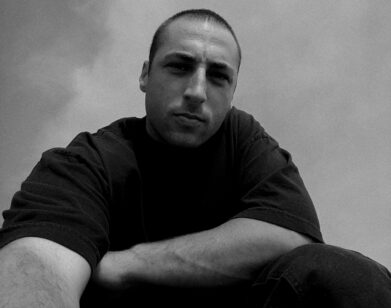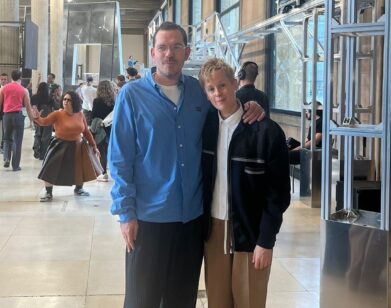Moby Discusses His ISSUEs

Photos by Thomas Cantley
The month of April marks the six-year anniversary for ISSUE Project Room, the performance space that opened in the East Village in April 2003, and has moved twice, most recently finding itself in Gowanus, Brooklyn. The address is changing yet again, this time to Downtown Brooklyn, but renovations and funding needs slow this transition significantly. Founder and creative director Suzanne Fiol, Moby, and I sat down to talk about past performances at ISSUE that failed and why toxicity is great for real estate. Moby’s also supporting a forthcoming record release, Wait For Me, due out at the end of June, and he showed a disturbing, beautiful music video for recent single “Shot in the Back of the Head,” directed by David Lynch. Afterwards, guests including Steve Buscemi gathered in an oversized, candlelit garage where Moby performed his first ever live solo ambient/electronic set. He played and swayed, eyes shut, against a montage of projected images—from a bizarre animated ballet to houses that whiz by as if driving a suburban street and looking out the window to trippy, psychedelic color patterns.
NELL ALK: So this is your first ever ambient or electronic show. That’s surprising.
MOBY: Yes. I’ve been making electronic music for twenty some odd years but, because I grew up playing in punk rock bands, when I started touring, I thought in order to be a viable touring musician I had to do it with a band. I would DJ or tour with a full rock band. When Suzanne [Fiol, founder of ISSUE Project Room] asked me to be involved in this, I realized I’d never done a solo electronic show, which is strange, being an electronic musician.
NA: What’s specific to ISSUE that brought it out in you?
MOBY: Maybe it’s a form of overcompensation, but whenever I’ve toured, I’ve always needed a huge performance component. One of the things I love about ISSUE is that it’s so focused on the music. You come here and you sit and you listen. There are visuals sometimes, but it’s not like a traditional performance where there are people running around onstage. The show I’m doing tonight is something I’ve never done before; I’m just presenting the music, not singing and not talking and not stage-diving and not climbing scaffolding.
NA: So tonight is solely audio?
MOBY: There’s projections. It’s amazing.
NA: So no body-surfing. Would you mind talking a bit about your forthcoming album?
MOBY: It’s a lot quieter and more mournful and more melodic than some of the records I’ve made in the past. The last record I made was a really fun dance record and this record is more like Sunday morning, 9 AM, laying in bed when it’s raining outside. It’s called Wait For Me and it’s very pretty. With this record, when I was making it, I wasn’t concerning myself with any of the commercial ramifications; I just wanted to make a really pretty record that I liked. And, if other people like it, great. And, if they don’t, that’s okay.
NA: Do you have any guest artist appearances?
MOBY: I do, but no famous people. Can’t do any work with a rock star; you have to go through their lawyers and their agents and their managers and you have to book them hotel rooms. When you work with your friends, you just call them up and they come over and you record and then you go out to see a movie.
NA: How often do you sing on the record?
MOBY: On this record, there are sixteen songs, and I only sing on one of them. I don’t think of myself as a singer; I usually end up singing when I can’t find anyone better to sing, or when I’m too lazy to find someone better. I like singing, but it’s certainly not my strong point.
NA: So, Suzanne, how did ISSUE get started?
SUZANNE FIOL: It was something that felt really necessary. A lot of music spaces and art and performance spaces were closing. It was in the East Village, which is a neighborhood of artists and no art spaces, so everybody was really happy to see it. Then, like most art spaces, we got kicked out. We moved to Brooklyn. We got a great silo that we did work in for two years. Then, we got kicked out of there and now we’re here.
NA: You’re celebrating six years this month.
SF: Six years [it was, on] April 11. It’s crazy.
NA: And how long have you been involved, Moby?
MOBY: I’d known about ISSUE since its inception. I started coming to events. Now I’m on the advisory board, and the focus right now, in addition to putting on performances, is raising enough money to renovate the new space. There’s this beautiful space in downtown Brooklyn and, in order for it to be a home for ISSUE for twenty years, we need to raise enough money to renovate it.
SF: One of my main reasons for having a space is that artists get paid properly; they get paid what they should be getting paid. That’s important stuff.
NA: Isn’t Gowanus a terribly toxic place?
MOBY: I love the Gowanus area, but if you google “Gowanus” and “toxic,” about 500,000 things will pop up. I believe this is one of the most polluted areas in the United States, which, I guess, to some extent, contributes to its charm. It’s been an industrial area for such a long time. And, in a weird way, the fact that it’s so toxic is actually preventing gentrification. People have wanted to develop stuff here and they just can’t.
SF: It’s like Williamsburg. That’s built on a toxic waste dump too.
MOBY: One of the wonderful things about the new space is that it’s so easy for everyone to get to. A lot of my friends who grew up in Manhattan have a strange phobia about Brooklyn. It’s big and scary and they get lost. Even a provincial, phobic Manhattanite won’t have a problem going to the new space.
NA: When are you moving?
SF: As soon as the space is ready.
NA: What does experimental culture mean for you?
MOBY: By it’s very definition it can mean myriad different things. For me, primarily it’s artistic expression that’s not bound by commercial constraints. The artist or the musician or the writer is given free reign to express themselves however they so choose without worrying about the market viability of what they’re doing. Sometimes I love the marriage of art and commerce; I love Donald Summer; I like the Rolling Stones.
NA: What are some of your favorite ISSUE performances over the years?
SF: We had a wonderful performance last week. It was Steve Buscemi and Tim Robbins and Richard Hell and Sean Lennon. We’ve done like 1,500 performances. We’ve had maybe 15 not-so-great ones. I would never say who they are. They were not great because they were artists who were willing to come here; it’s called “Project Room” for a reason. It’s important to have a space where you can try something new and, if you don’t succeed, you don’t succeed. I have issues with artists who are afraid of failing.
MOBY: Whenever I’ve had success, I never learn from it. Success usually breeds a degree of hubris. When you fail, that’s when you learn. Musicians who come here and it hasn’t worked, I’m sure they’ve gotten a lot out of it.
NA: That’s a very New York mentality. Can you expand on your earlier comment about gentrification, or lack thereof?
MOBY: One of the downsides of gentrification is that, as rents have gone up, in general, it’s made people a lot less inclined towards experimentation. New York is such a competitive place; it tears people apart. People come here and, if they can’t make it in the first month, they get torn apart and they have to go back to where they came from. I don’t think that’s terribly healthy. It can be invigorating at times, but there has to be a balance between competition and support. When the balance skews so far toward competition, the city becomes packs of hyenas running around tearing each other apart.
The new ISSUE Project Room will relocate to 110 Livingston Street, Brooklyn. It is still at the Old American Can Factory, 232 3rd Street, 3rd Floor, Brooklyn.






